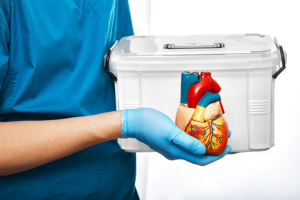Congress Newsletter 2021
EA21 Newsletter: Successful heart transplant in 31-year-old Covid patient
- It was decided that the operation, one of the first in the world, was his best chance of survival
- “It is through pushing boundaries like these that discoveries – and medical advances – are made,” says his doctor
In the first of our abstract watch articles this year, Doctors in Brazil describe a heart transplant in a young COVID-19 patient, in a case report being presented at this years Euroanaesthesia.
More than 110,000 heart transplants have been performed around the world since Christiaan Barnard performed the first procedure in 1968. Doctors, however, remain concerned about carrying out transplants on patients carrying new diseases. Covid is no exception, with little known about the outcome of heart transplants in patients who have had the virus.
The patient, a 31-year-old man, had the procedure at the Hospital Israelita Albert Einstein in Sao Paulo in May 2021, while he was still recovering from Covid.
The transplant, one of the first cases of its kind anywhere in the world, illustrates that heart transplants can be successful after severe Covid infections, says Dr Eduardo Mocsári who, along with fellow anaesthesiologists Thales Tedoldi, Jose Mateus Costa, Marina Cordeiro and Luiz Guilherme Villares da Costa, was part of the team who carried out the op.
The patient had been diagnosed with familial inherited cardiomyopathy, an inherited heart condition, two years earlier. His health had then rapidly deteriorated and he developed heart failure, in which the heart is unable to pump blood around the body properly.
He was listed for a heart transplant after his heart failure continued to worsen, despite being treated with high doses of inotropic drugs and an LVAD (a surgically implanted mechanical pump).
By the time of his transplant, he had a left ventricular ejection fraction (a measure of how well the heart is pumping blood) of 15%. A normal result is 50 to 70%.
He tested positive for COVID-19 during admission and the procedure was postponed. The patient went on to develop a fever and respiratory failure, for which he was put on a ventilator. This was followed by cardiogenic shock (a life-threatening condition in which the heart suddenly can’t pump enough blood to meet your body’s needs), for which he was put on ECMO (a machine that replaces the function of the heart and lungs).
His heart continued to deteriorate and, after his respiratory symptoms started to improve, it was decided that although he hadn’t completely recovered from Covid, the transplant gave him the best chance of survival.
The transplant was carried out on 4 May 2021, 42 days after he was diagnosed with Covid.
The patient was testing negative for Covid at that point but still required a ventilator and ECMO and the team wore full PPE during the transplant.
The five-hour operation went smoothly and, with his new heart working well, the patient no longer needed a mechanical heart pump. He then spent 20 days in intensive care and was discharged from the hospital 66 days after his transplant.
He developed one complication, necrosis of his toes, which led to some of his toes being amputated and will take immunosuppressant drugs for life to prevent the new organ from being rejected.
Dr Mocsári says that although heart transplant is the gold standard surgical treatment for heart failure that isn’t responding to other therapies, COVID-19 adds an extra layer of risk. As a result, doctors have been hesitant about carrying out heart transplants on Covid patients.
He adds: “Heart transplantation after COVID-19 infection is something new and we are still learning about the risks and complications.
“In this case, the patient hadn’t fully recovered and we were concerned his Covid would worsen. Several studies have indicated that transplant patients are at greater risk of more severe Covid and of dying from the disease.*
“But, as his heart was still deteriorating, we decided that the transplant gave him the best chance of survival.
“As this case illustrates, despite there being few reports in the literature, heart transplantation in patients who have had severe COVID-19 can have a favourable outcome.
“There are situations, where despite all the unknowns, a transplant is the best option. It is through pushing boundaries like these that discoveries – and medical advances – are made.”
Currently, the patient is hospitalized due to an abdominal infection but has responded well to treatment and is on his way to being discharged. In addition to immunosuppressants (Tacrolimus and Mycophenolate), he is also taking antibiotics.
Author Dr Eduardo Mocsári, Hospital Israelita Albert Einstein, Sao Paulo, Brazil can be contacted as follows E) eduardoferro03@gmail.com
For the full abstract click here
For the full poster click here
Read More of our special newsletter covering our virtual congress.










